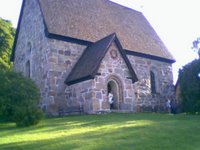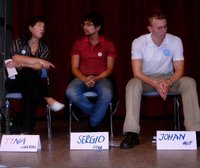This year I got two new courses I like pretty much. Both are cultural history classes and they are called History of culture and ideas and The city and the future. Today we joined the esthetic programme, who also have the history of culture and ideas course, on a 2 hour long trip to my place of birth.
Trönö, which is the wonderful place i spent most of my childhood in, is located about 18 kilometers out of town and has got about 950 people living there.
The reason we went to Trönö for these courses is that in Trönö we've got two very special churches.
The first stop was the old church




This church is actually Norrland's best-preserved church setting from the Middle Ages. The architecture hints at the 16th century, but its history is older, going back a further 300 years. The free-standing bell tower is not as old, but still some hundreds of years old as well. Its form is reminiscent of older Norwegian stave churches, with shingled roof and shingle-clad timbers.
In front of the church and behind it, there are bodies of about 10 000 buried people. We cannot know that for sure, of course, but if you calculate on it that would be the number. Around all this there's a bogårdsmur, which is a churchyard wall with wooden roof. This wall was probably built to keep animals outside the yard. This wall is also dated from the middle ages and has got two lychgates. The oldest one got to be the mens entrance when they built the latter one, which of course became the entrance for women. In the eldest lynchgate, you can climb up some stairs, made of stone just as the wall and the gate, and from here it is believed the priest was splashing some holy water on the people who went to church. This custom was lost when the Protestant reformation reached Sweden and our king Gustav Vasa opressed the Catholic church.
Next stop was at the so called new church.






Trönö New Church was completed in 1895 and several features from the old church were moved to the new, including a celebrated reliquary from thirteenth century France.
This new church however was destroyed by fire in 1998 and many cultural treasures were lost. The unique Trönöskrinet reliquary from the 13th century was however restored by the National Heritage Board and can once again be seen in Trönö church.
The new and renovated church made the local people start talking. One side thought they should restore it so that it looked like it did before the fire. The other side wanted something new and modern. It all ended up with just half the church with ceiling, and the other half became a, in my opinion, lovely outdoor room. Here climbs roses up the walls and you feel the nature close up. I do not have any pictures of what this church looks like inside, but it's also very fresh, clean and modern. It's very airy and not paintings or statues or anything all over the walls. White, mint green and gold are the colours which are used in here. The big windows are clean with abstract patterns or something else which makes you think a bit further or meditate about things. It's simply a free and peaceful place for your mind to wander by itself.
Trönö, which is the wonderful place i spent most of my childhood in, is located about 18 kilometers out of town and has got about 950 people living there.
The reason we went to Trönö for these courses is that in Trönö we've got two very special churches.
The first stop was the old church




This church is actually Norrland's best-preserved church setting from the Middle Ages. The architecture hints at the 16th century, but its history is older, going back a further 300 years. The free-standing bell tower is not as old, but still some hundreds of years old as well. Its form is reminiscent of older Norwegian stave churches, with shingled roof and shingle-clad timbers.
In front of the church and behind it, there are bodies of about 10 000 buried people. We cannot know that for sure, of course, but if you calculate on it that would be the number. Around all this there's a bogårdsmur, which is a churchyard wall with wooden roof. This wall was probably built to keep animals outside the yard. This wall is also dated from the middle ages and has got two lychgates. The oldest one got to be the mens entrance when they built the latter one, which of course became the entrance for women. In the eldest lynchgate, you can climb up some stairs, made of stone just as the wall and the gate, and from here it is believed the priest was splashing some holy water on the people who went to church. This custom was lost when the Protestant reformation reached Sweden and our king Gustav Vasa opressed the Catholic church.
Next stop was at the so called new church.






Trönö New Church was completed in 1895 and several features from the old church were moved to the new, including a celebrated reliquary from thirteenth century France.
This new church however was destroyed by fire in 1998 and many cultural treasures were lost. The unique Trönöskrinet reliquary from the 13th century was however restored by the National Heritage Board and can once again be seen in Trönö church.
The new and renovated church made the local people start talking. One side thought they should restore it so that it looked like it did before the fire. The other side wanted something new and modern. It all ended up with just half the church with ceiling, and the other half became a, in my opinion, lovely outdoor room. Here climbs roses up the walls and you feel the nature close up. I do not have any pictures of what this church looks like inside, but it's also very fresh, clean and modern. It's very airy and not paintings or statues or anything all over the walls. White, mint green and gold are the colours which are used in here. The big windows are clean with abstract patterns or something else which makes you think a bit further or meditate about things. It's simply a free and peaceful place for your mind to wander by itself.









